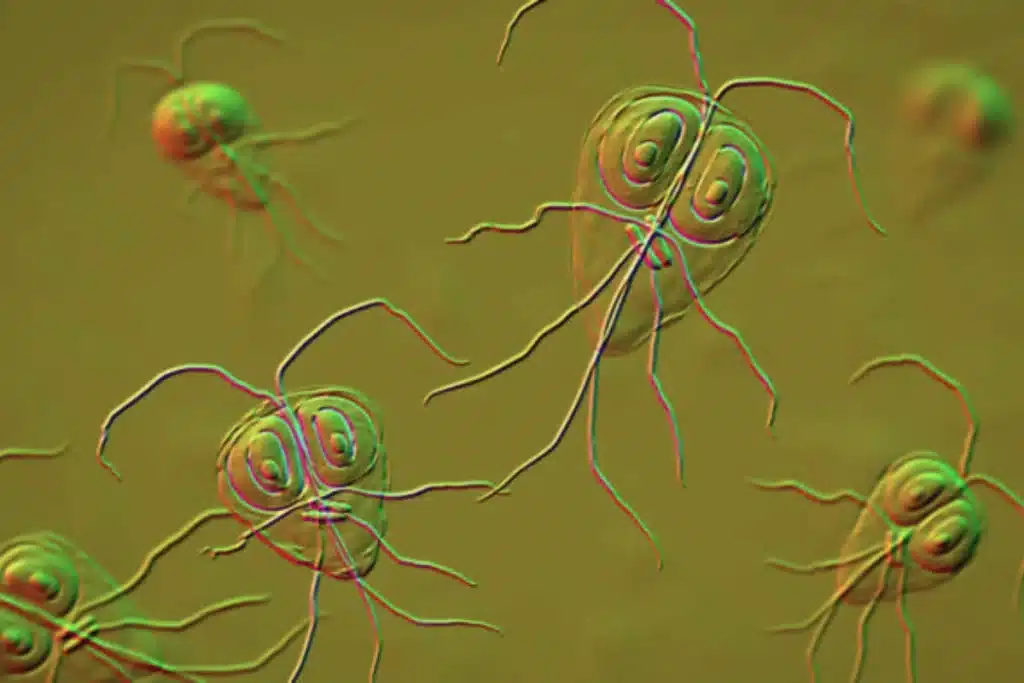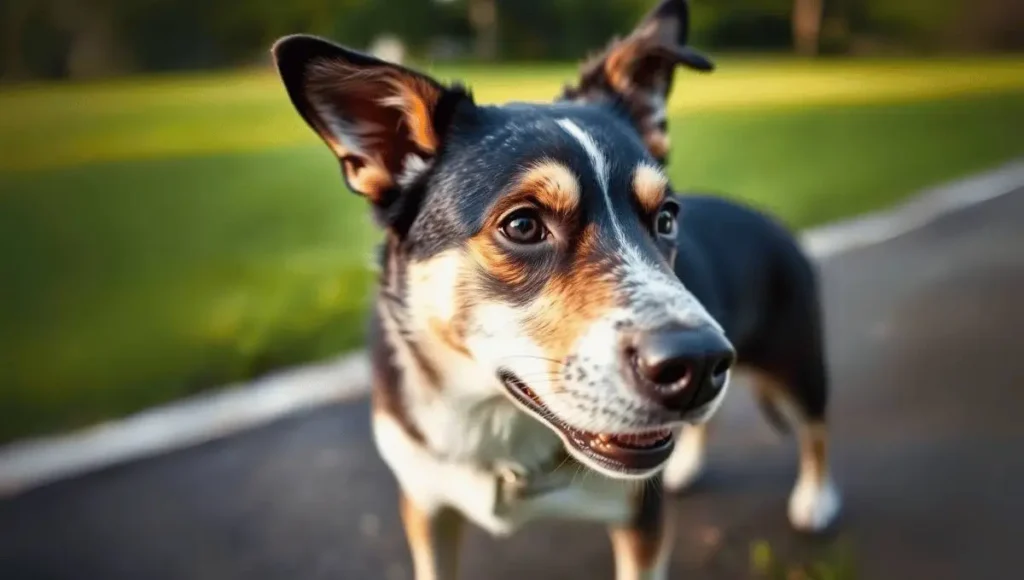Giardia is a microscopic parasite that affects the intestines of dogs and can lead to significant digestive upset. The infection, known as giardiasis, spreads when dogs ingest contaminated water, food, or feces. It often goes unnoticed until symptoms like diarrhea or foul-smelling stool appear.
Recognizing the presence of Giardia in dog feces is vital for early treatment. Owners must pay close attention to any changes in their pet’s stool. A single Giardia dog poop picture can help identify abnormalities such as mucus, discoloration, or an unusually greasy texture. Images of infected poop not only guide concerned owners but also assist veterinarians in making a quicker diagnosis. By comparing photos with real symptoms, people can take quicker action to treat and protect their pets.
Table of Contents
What Is Giardia in Dogs?
Giardia is a single-celled parasite that thrives in the intestinal tract of various animals, including dogs. The infection it causes is known as giardiasis and is relatively common, especially in puppies and dogs with weak immune systems. This microscopic organism attaches to the walls of the intestines and disrupts normal digestion, often leading to watery or foul-smelling stool.
Dogs can become infected with Giardia by ingesting contaminated water, food, or fecal matter. Common sources include puddles, streams, shared water bowls, or contact with infected animals. Even licking paws that stepped in contaminated soil can transmit the parasite. Giardia in dogs can go undetected at first, but once symptoms appear, it’s important to act quickly. Dogs do not build lasting immunity to Giardia Dog Poop Picture, which means reinfection is always a risk without proper prevention.
Symptoms of Giardia in Dogs
Giardia infections can present a variety of symptoms in dogs, depending on the severity of the infestation and the animal’s overall health. One of the most recognizable signs is diarrhea, often soft, watery, and unusually foul-smelling. In some cases, the stool may appear greasy or contain visible mucus, which is an indicator of digestive upset. Pet owners may also notice their dog having frequent bowel movements or signs of urgency.
Aside from digestive issues, Giardia symptoms in dogs can include general fatigue, reduced appetite, and gradual weight loss. Puppies or dogs with weakened immune systems are particularly vulnerable to the effects of this parasite. Some dogs may show no symptoms at all yet still shed cysts in their stool, making them contagious to others. Identifying these subtle health shifts early on can be critical to initiating effective treatment and limiting the spread of infection.
What Does Giardia-Infected Dog Poop Look Like?
Identifying Giardia Dog Poop Picture stool can be tricky, but certain visual signs can raise suspicion. Infected dog poop is often loose, greasy, and pale in color. Unlike firm and well-formed stools seen in healthy pets, poop from a Giardia-infected dog may have a mushy consistency and carry a noticeably foul odor. In some cases, mucus may be present, giving it a slimy coating or streaky appearance.
The presence of such symptoms separates this type of stool from normal waste. Dog owners might notice their pet’s poop changing shape, smell, and frequency of passing. The abnormal texture and shine are a direct result of intestinal irritation caused by the parasite. If you observe these unusual features in your dog’s stool, it’s wise to collect a fresh sample for veterinary analysis and take note of changes using a poop chart for dogs for reference.
Giardia Dog Poop Picture: How It Helps
Visual references play a key role in helping pet owners recognize potential signs of infection. A Giardia dog poop picture offers a useful comparison for identifying unusual stool characteristics such as looseness, mucus coating, or discoloration. These images provide a point of reference for what infected feces might look like, enabling quicker decision-making when unusual signs are observed in your pet.

If you suspect Giardia Dog Poop Picture, taking a clear and well-lit photo of your dog’s stool can be helpful for your veterinarian. Make sure the picture is taken on a clean surface, with natural light, and includes the entire sample. This helps vets understand the situation before lab tests are conducted. Though not a substitute for diagnostic testing, sharing a picture of dog poop with vet staff can support faster assessments and early treatment decisions.
Diagnosing Giardia in Dogs
While stool changes may suggest Giardia, a veterinarian’s confirmation is essential for accurate diagnosis. The most common method is a fecal exam, where a fresh sample is tested for Giardia cysts under a microscope. In some cases, vets use an ELISA test to detect Giardia antigens, which can provide a more reliable result, especially when the cysts are not visible in every sample.
Though a Giardia Dog Poop Picture stool sample from a dog may appear visibly suspicious, relying on appearance alone is not enough. Some healthy-looking dogs can still carry the parasite and spread it to others. That’s why visual symptoms should always be followed by professional testing. If your vet suspects giardiasis, they may request multiple stool samples collected over a few days to increase diagnostic accuracy.
Treatment and Prevention
The treatment for Giardia in dogs typically includes antiparasitic medications prescribed by a veterinarian. Two of the most commonly used options are metronidazole for dogs and fenbendazole for humans, both proven effective at eliminating the parasite. While these medications help clear the infection, it’s important to complete the full course even if symptoms seem to improve early on.
Alongside medical treatment, proper hygiene is critical to preventing reinfection. Disinfect surfaces your dog comes into contact with, such as bedding, crates, and bowls. Always pick up poop immediately and dispose of it properly to reduce environmental contamination. Ensure your dog drinks clean, filtered water, avoiding lakes or puddles that may contain Giardia. Bathing your dog after treatment may also help remove any cysts on their fur that could lead to reinfection.
Conclusion
Spotting changes in your dog’s poop can be a vital early warning sign of Giardia Dog Poop Picture or other health issues. A greasy texture, mucus, or unusually foul odor may indicate an intestinal parasite that needs medical attention. Observing your dog’s stool regularly and knowing what’s normal can help catch infections early and prevent further health complications.
If you ever notice something unusual, don’t hesitate to reach out to your veterinarian. Bringing a recent stool sample and even sharing a dog poop photo for vet review can assist in diagnosis. While images alone aren’t enough, they serve as helpful visual cues alongside lab tests. Staying informed, practicing good hygiene, and working closely with your vet are the best ways to protect your pet from giardiasis and other intestinal infections.
FAQ’s
What is Giardia dog poop in dogs?
Giardia is a microscopic parasite that infects a dog’s intestines, leading to digestive problems such as diarrhea and weight loss. Dogs become infected by ingesting contaminated water, soil, or feces. Recognizing signs early can help treat the infection before it spreads.
What does Giardia dog poop picture look like?
Infected dogs often have loose, foul-smelling stool that may appear greasy or contain mucus. If you’re unsure, comparing it to a Giardia dog poop picture can help identify the distinct characteristics of an infected stool.
How can I prevent my dog from getting Giardia?
A dog with Giardia is typically contagious as long as cysts are present in its stool. This can last for weeks, even after symptoms improve, so proper treatment and hygiene are essential to avoid spreading it.
What naturally kills Giardia?
Some natural remedies, like pumpkin and probiotics, can support digestion but don’t directly kill Giardia. Coconut oil may offer mild antimicrobial effects, but consult your vet before relying on natural treatments for Giardia.
How can I prevent my dog from getting Giardia?
Prescription medications like Metronidazole and Fenbendazole are effective for treating Giardia in dogs. Cleaning and disinfecting their environment also help eliminate Giardia cysts, reducing the risk of reinfection.
More Articles
Cat Bump After Break Radius: Diagnosis, Causes & Solutions
German Shepherd Husky Mix: The Ultimate Guide
Hookworms in Dogs: Causes, Symptoms, and Fast Treatments
Can Dogs Eat Enoki Mushrooms: A Comprehensive Guide

